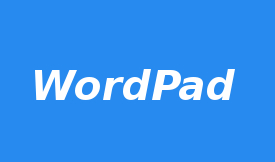MicrosoftWordPad is a free rich texteditor and word processor, first included with Microsoft Windows 95 and all versions since. Although capable of doing more than Notepad, WordPad is not as advanced as Microsoft Word. However, it does give you additional features, such as the capability of inserting pictures and text formatting. The picture below shows an example of Microsoft WordPad.

A logo created in Microsoft Word can be directly used on a letterhead. Microsoft Word offers a stunning range of amazing fonts to create a logotype. Plus, you can make all kinds of creative choices, including pasting a text into different shapes, experimenting with WordArt objects, adding patterns, and playing around with textures and backgrounds. Looking for Wordpad fonts? Click to find the best 1 free fonts in the Wordpad style. Every font is free to download!

This wikiHow teaches you how to insert your own images into a document you created using a Microsoft Office template. Many templates, such as brochures and fliers, come with sample images that can be replaced with your own. You can also insert your own images into various locations in your document, such as your company's logo or your signature.
Microsoft WordPad is capable of editing and saving plain-text file (.txt), rich text format (.rtf), Microsoft Word (.doc or .docx), and OpenDocument text (.odt) format files.
NoteNot all versions of WordPad support all above formats. Windows 95, Windows 98, Windows ME, and Windows XP does not support the .docx format. Windows 7 introduced the support of .odt files, so early versions of Windows do not support this format as well.

How to open Microsoft WordPad
Users who are using a version of Microsoft Windows that supports WordPad can run Microsoft WordPad (wordpad.exe) by following the steps below.
Windows 10
- Click the Start menu.
- Type wordpad and press Enter.
Windows 8
- On the Start screen, type wordpad.
- In the search results, click the WordPad program.
Windows 7 and earlier
- Click the Start menu.
- Click the Run option.
- Type wordpad or write, then press Enter.
OR

- Click the Start menu.
- Click Programs and then Accessories.
- Click the Wordpad icon.
Why use Word instead of a WordPad?
A rich-text editor like WordPad offers many of the same basic features as Microsoft Word. Where Microsoft Word differs is the ability to do more advanced features. Some of the advanced features include mail merges, spellchecker, styles, tables, headers & footers, WordArt, columns, margins, and more.
Wordpad Logotipo
Related pages
Wordpad Logopedia
CamelCase, Editor, Notepad, Software terms, TextEdit, Word, Word processor, Word processor terms